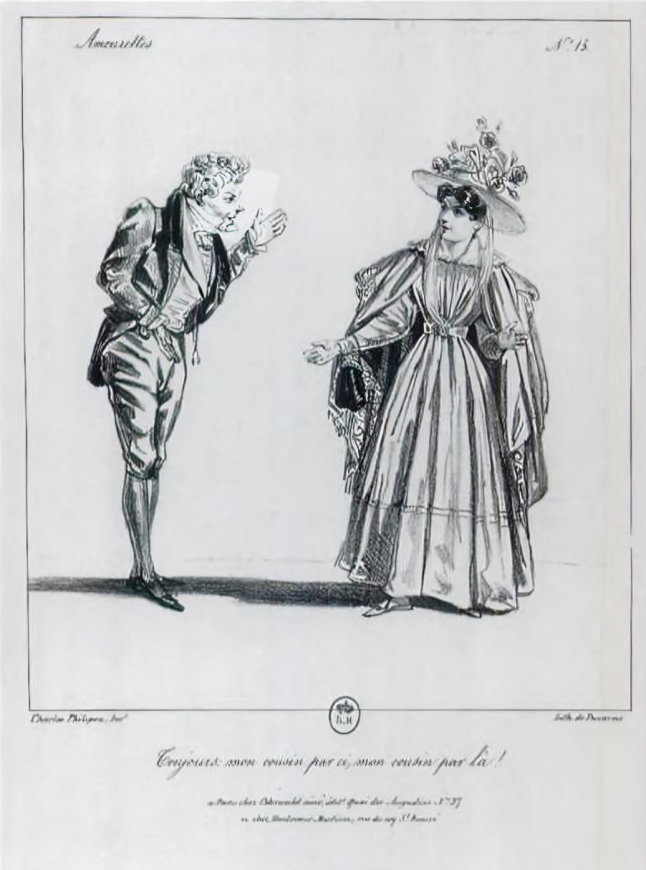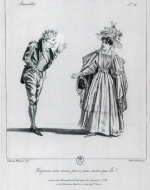Created by Kaitlynn Wolffe on Wed, 10/16/2024 - 09:09
Description:
Marriage and courtship in the Regency era were steeped in a complex dichotomy between the longing for romantic affection and the societal expectations of transactional relationships. While often romanticized in literature like Jane Austen’s novels, and popular culture, this period was strongly governed by practical considerations that frequently overshadowed individual desires for love and emotional connection. The picture above expresses this conflict clearly, as the man finds himself cross with the lady, as she is always hanging out with her cousin. This dichotomy is then displayed as loopholes within the strict social codes, such as relations with cousins, reveal the struggle between love and expectation (Mainardi 68).
Cousins were only the beginning of this deep conflict between love and marriage. Men and women practically lived on different planets, so until the moment of proposal, there was very little interaction between the two sexes. With cousins, they were a lady’s relative, so they were allowed to mingle while growing up and into adulthood. Although possibly incestuous, society saw cousins as distantly related enough that it would be alright while still being close enough that they could interact (105). Aside from cousins, men and women took any opportunity they could to get to know others beyond these strict and transactional social rules.
The transactional nature of courtship created an environment where genuine affection was frequently stifled by the prioritization of social and financial gain. Young women, often chaperoned and restricted in their interactions, were trained to present themselves as desirable without openly expressing their feelings. They were expected to attract suitors through charm and propriety, but the underlying assumption was that love would follow once a suitable match was made. This is seen within Pride and Prejudice through Charlotte Lucas’ and Mr. Collin’s marriage. Charlotte Lucas focused more so on the financial and social benefits of being a wife, while believing that she would be able to tolerate Mr. Collins and hopefully build affection later on. Romantic love, both in reality and in literature, then, was often viewed as an ideal rather than a prerequisite for marriage.
Conversely, men faced societal pressures to be assertive in their pursuit of a suitable bride, often prioritizing familial approval and social considerations over personal desire. A man's reputation was closely tied to his ability to secure a wealthy or well-connected wife, and as such, the pursuit of love could feel more like a competitive endeavor than a heartfelt connection. Emotional vulnerability was largely discouraged, with men expected to maintain a façade of confidence and control.
Ultimately, the dichotomy between romantic affection and transactional marriage during the Regency era illuminated the struggles individuals faced in reconciling personal desires with societal expectations. While the institutional pressures of the time often overshadowed true emotional connections, the seeds of change were sown as voices advocating for love, companionship, and genuine connection began to emerge. As the era progressed, these shifting ideals laid the groundwork for more modern concepts of marriage, where love and partnership would eventually come to take precedence over mere social contracts.
Works Cited
Philipon, Charles. “It’s Always ‘My cousin this, my cousin that!,’” Amourettes, 15, 1827. Lithograph. Lith. Ducarne, Dist. Ostervald l’ainé et Hautecoeur-Martinet. Bibliothéque nationale de France, Paris. (“Tonjours: mon cousin par ci, mon cousin par lá!”)
Mainardi, Patricia. “Husbands, Wives and Lovers: Marriage and Its Discontents in Nineteenth-Century France.” AbeBooks, Yale University Press, 1 Jan. 1970, www.abebooks.com/9780300101041/Husbands-Wives-Lovers-Marriage-Discontent....
Copyright:
Associated Place(s)
Part of Group:
Artist:
- Charles Philipon


